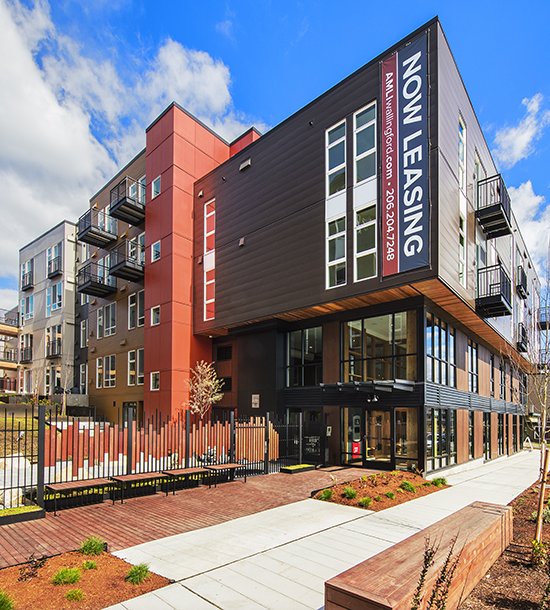|
Subscribe / Renew |
|
|
Contact Us |
|
| ► Subscribe to our Free Weekly Newsletter | |
| home | Welcome, sign in or click here to subscribe. | login |
Construction
| |
 |
May 5, 2017
Eagle of Excellence • Mixed-Use Construction

AMLI Wallingford apartments
Rafn Co.
Architect: GGLO
Engineer: Coughlin Porter Lundeen
Owner: AMLI Residential
ABC members: Davis Door Service; Evergreen Concrete Cutting; Pacific 1 Construction; Premier Builders; Propel Insurance; Rainbow Federal; RC Painting & Sons; VanWell Masonry
Rafn began budgeting work for the 181,000-square-foot, 231-unit AMLI Wallingford apartments in 2014 when Seattle’s building boom was at its height.
The initial budget, affected by both rising costs and the complex structure, was much higher than expected so Rafn came up with a value engineering and scope cut list. That resulted in more than 100 cost-reduction strategies totaling approximately $1.2 million, making the project economically viable.
During permitting, AMLI voluntarily made major concessions to the design and configuration based on community input — adding a public plaza, moving the garage entrance, adding live-work units and minimizing the mass of buildings by creating a landscaped open area down the middle, and keeping the site of the Varsity Inn intact. AMLI also restored the quarter mile of streets and sidewalks surrounding the site, including those in front of the restaurant.
With all those changes, the design had to be completed on the fly, during construction.
To make up for lost time due to labor shortages, Rafn phased the project delivery and pursued early occupancy, allowing the first phase to be occupied five months ahead of the last.
The north site had been an aircraft parts manufacturer and chemicals from the facility had leached into the soil. This required exporting 15,000 cubic yards of contaminated soil and installing treatment wells for an ongoing liquid injection system. Rafn also tied the parking garage foundation drainage system to the vapor extraction system to collect any vapors leaching from the soil.
The complex design accommodated open courtyards, exterior steel stairs, exterior bridges and connecting towers — all while maximizing building height and interior ceiling heights. The building also has multiple floor levels that closely follow the grade of the sloping site, with hallways on two or three different levels on any given floor. The complexity of the unit arrangement made materials handling difficult and the standard construction practice of stacking units impossible.
To manage these challenges, Rafn employed 3-D modeling to understand the intricacies and visualize how it was meant to come together as well as discover, and correct, conflicts between structural beams and HVAC ductwork prior to construction.
Safety on this project took into account not only Rafn personnel and all of the subcontractors, but also pedestrians and vehicle traffic on the streets. In the 81,144 hours worked, there were three time-loss injuries and no incidents involving pedestrians or street traffic.
Other Stories:
- ABC mantra: Get into politics or get out of business
- Institutional Construction
- Historic Preservation/Restoration
- Electrical Construction
- Mechanical Construction
- Specialty Contracting: Exterior
- Survey: Stoneway Concrete
- Survey: Colvos Construction
- Survey: Compass General Construction
- Survey: Rafn Co.
- Survey: GLY Construction
- Multifamily Construction
- Tenant Improvement/Renovation
- 10 things developers must consider when hiring a GC
- Tech wizardry: What’s really behind the curtain?
- Time to put the brakes on 700 work zone deaths
- Equipment firms’ new focus: ‘power-by-the-hour’
- What every contractor should know about bonds
- Commercial Construction over $10 million
- Commercial Construction $1 million to $5 million
- Commercial Construction under $1 million
- Community & Public Service
- Healthcare
- Survey: PCL Construction Services


